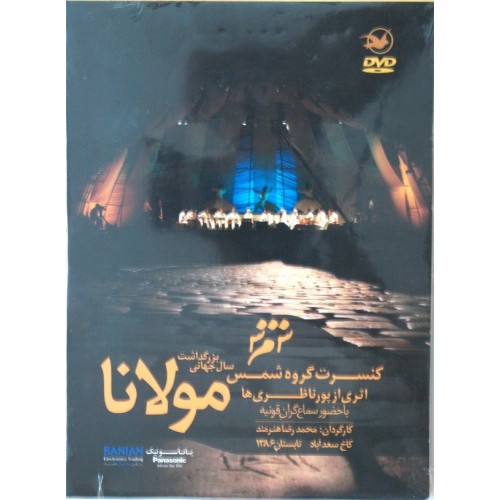- On sale!




Iran Persian Music Band SHAMS Concert in "International Rumi Year" (2007) DVD
Playing: Tanbur, Ney, Santur & Setar
The term tanbūr (Persian: تنبور) can refer to various long-necked, fretted lutes originating in the Middle East or Central Asia. According to the New Grove Dictionary of Music and Musicians, "terminology presents a complicated situation. Nowadays the term tanbur (or tambur) is applied to a variety of distinct and related long-necked lutes used in art and folk traditions. Similar or identical instruments are also known by other terms."
++++++++++
The santur (also santūr, santour, santoor ) (Persian: سنتور) is a Persian hammered dulcimer It is a trapezoid-shaped box often made of walnut or different exotic woods. The Persian classical santur has 72 strings. The name santur was first referenced in ancient Persian poetry. To date there has never been verifiable evidence what this name actually means, it is just a name and the only meaning it has in the Persian language is this instrument. The oval-shaped Mezrabs (mallets) are feather-weight and are held between the thumb, index and middle fingers. A typical Persian santur has two sets of bridges, providing a range of approximately three octaves. The right-hand strings are made of brass or copper, while the left-hand strings are made of steel. Two rows of 9 articles called "kharak" (total of 18 kharaks) divide the santur into three positions. Over each bridge crosses four strings spanning horizontally across the right and left side of the instrument. There are three sections of nine pitches: each for the bass, middle and higher octave called Poshte Kharak (behind the left bridges) comprising 27 notes all together. The top "F" note is repeated 2 times, creating a total of 25 separate tones in the Santur. The Persian santur is primarily tuned to a variety of different diatonic scales utilizing 1/4 tones (semi-tones) which are designated into 12 Dastgah's (modes) of Persian classical music. These 12 Dastgah's are the repertory of Persian classical music known as the Radif.
++++++++++
The ney
(Persian: نی/نای; Arabic: ناي; Turkish: ney; also nai, nye, nay, gagri tuiduk,
or karghy tuiduk ) is an end-blown flute that figures prominently in Middle
Eastern music. In some of these musical traditions, it is the only wind
instrument used. It is a very ancient instrument, with depictions of ney players
appearing in wall paintings in the Egyptian pyramids and actual neys being found
in the excavations at Ur. This indicates that the ney has been played
continuously for 4,500–5,000 years, making it one of the oldest musical
instruments still in use. It is a forerunner of the modern flute.
The ney consists of a piece of hollow cane or reed with five or six finger holes
and one thumb hole. Modern neys may be made of metal or plastic tubing instead.
The pitch of the ney varies depending on the region and the finger arrangement.
A highly skilled ney player can reach more than three octaves, though it is more
common to have several "helper" neys to cover different pitch ranges or to
facilitate playing technical passages in other maqamat.
In Romanian, the word nai is also applied to a curved Pan flute.
++++++++++
Setar (Persian: سه تار, from seh, meaning "three" and tār, meaning "string") is a Persian musical instrument. It is a member of the lute family. Two and a half centuries ago, a fourth string was added to the setar, which has 25 - 27 moveable frets. It originated in Persia before the spread of Islam.
pThe term /b p